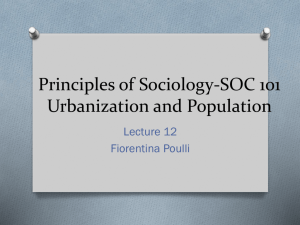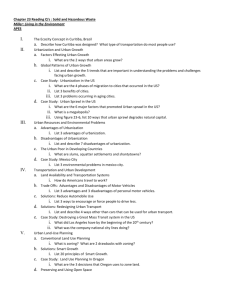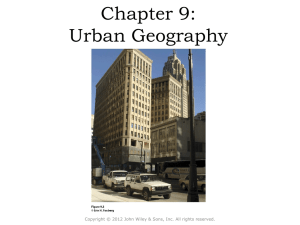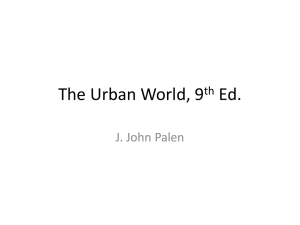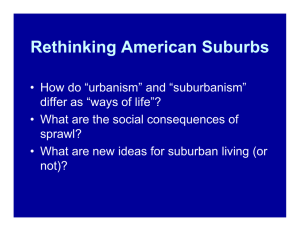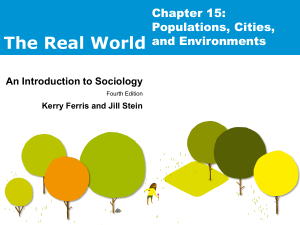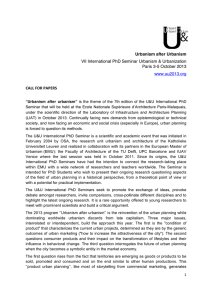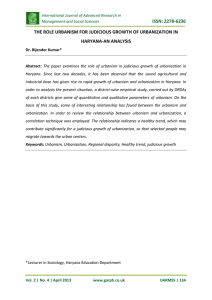Chapter 15 Population and urbanization
advertisement
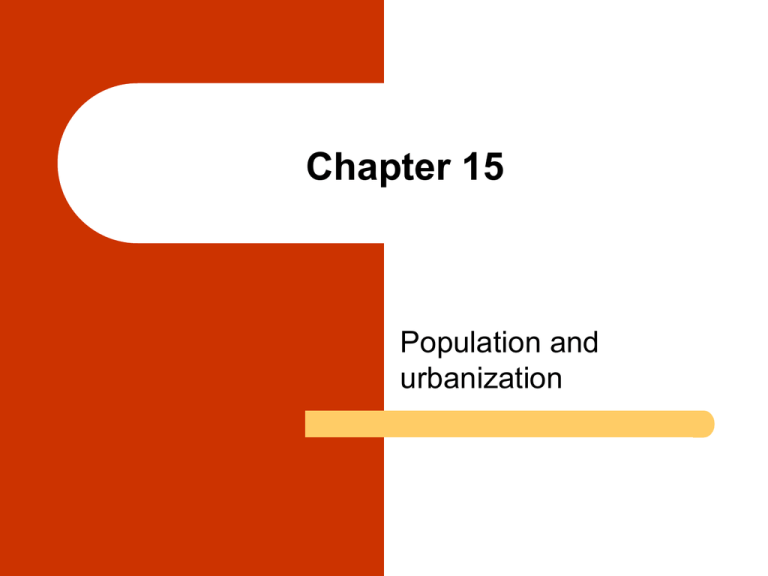
Chapter 15 Population and urbanization Chapter Outline Demography: The Study of Population Population Growth in Global Context A Brief Glimpse at International Migration Theories Urbanization in Global Perspective Perspectives on Urbanization and the Growth of Cities Problems in Global Cities Urban Problems in the United States Population and Urbanization in the Future Population World’s population of 6.2 billion in 2000 is increasing by more than 76 million people per year. Between 2000 and 2030, almost all of the world’s population growth will be in low-income countries. By 2015: Population of high income nations will increase by 120 million and population of lowincome nations will increase by 1.7 billion. Changes in Population Changes occur as a result of three processes: fertility (births) mortality (deaths) migration Ten Leading Causes of Death in the United States, 1900 and 1997 Cause of Death—1900 Rank Cause of Death—1997 Influenza/pneumonia 1 Heart disease Tuberculosis 2 Cancer Stomach/intestinal disease 3 Stroke Heart disease 4 Chronic lung disease Cerebral hemorrhage 5 Accidents Kidney disease 6 Pneumonia and influenza Accidents 7 Diabetes Cancer 8 HIV Diseases in early infancy 9 Suicide Diphtheria 10 Homicide Migration Two types of movement: Immigration is the movement of people into a geographic area to take up residency. Emigration is the movement of people out of a geographic area to take up residency elsewhere. Theories of Population Growth The Malthusian Perspective The Marxist Perspective The Neo-Malthusian Perspective Demographic Transition Theory The Malthusian Perspective If left unchecked, the population would exceed the available food supply. Population would increase in a geometric progression (2, 4, 8, 16 . . . ) . The food supply would increase only by an arithmetic progression (1, 2, 3, 4 . . .). The Marxist Perspective Using technology, food can be produced for a growing population. Overpopulation will lead to the eventual destruction of capitalism. Workers will become dissatisfied and develop class-consciousness because of shared oppression. The Neo-Malthusian Perspective Overpopulation and rapid population growth result in global environmental problems. People should be encouraging zero population growth. Demographic Transition Theory Stage 1: Preindustrial Societies - little population growth, high birth rates offset by high death rates. Stage 2: Early Industrialization - significant population growth, birth rates are relatively high, death rates decline. Demographic Transition Theory Stage 3: Advanced Industrialization and Urbanization - very little population growth occurs, birth rates and death rates are low. Stage 4: Postindustrialization - birth rates decline as more women are employed and raising children becomes more costly. World Population in the Future World population is increasing 1.8% per year. Since many women are of childbearing age, replacement fertility results in more births than deaths. Demographic shifts contribute to a reduction in fertility rates and population growth. Development of a City Three preconditions: A favorable physical environment. An advanced technology that could produce a social surplus. A well-developed political system to provide social stability to the economic system. Gender Regimes in Cities Different cities have different gender regimes: How women and men should think, feel, and act. How access to positions and control of resources should be managed. How women and men should relate to each other. Simmel's View of City Life Urban life is stimulating; it shapes people's thoughts and actions. Many urban residents avoid emotional involvement with each other and try to ignore events taking place around them. Urban living can be liberating - people have opportunities for individualism and autonomy. Gans's Urban Villagers Five categories of urban dwellers: 1. Cosmopolites are students, artists, writers, musicians, and professionals who live in the city to be close to its cultural facilities. 2. Unmarried people and childless couples live in the city to be close to work and entertainment. Gans's Urban Villagers 3. 4. 5. Ethnic villagers live in ethnically segregated neighborhoods. The deprived are poor people with dim future prospects. The trapped are downwardly mobile persons, older persons, and addicts who cannot escape the city. Suburbs Since World War II, the U.S. population has shifted as people moved to the suburbs. Suburbanites rely on urban centers for employment but pay property taxes to suburban governments and school districts. Functionalist Perspective on Urbanism: Ecological Models Concentric zone model Sector model Due to invasion, succession, and gentrification, cities are a series of circular zones, each characterized by a particular land use. Cities consist of wedge-shaped sectors, based on terrain and transportation routes, with the most expensive areas occupying the best terrain. Multiple nuclei Cities have more than one center of development, model based on specific needs and activities. Conflict Perspective on Urbanism: Political Economy Models Capitalism and urban growth The capitalist class chooses locations for skyscrapers and housing projects, limiting individual choices by others. Gender regimes in cities Different cities have different ideologies regarding access to social positions and resources for men and women. Global patterns of growth Capital investment decisions by core nations result in uneven growth in peripheral and semiperipheral nations. Symbolic Interactionist Perspective on Urbanism Simmel’s view The intensity of city life causes people to become of city life insensitive to individuals and events around them. Urbanism as a Size, density, and heterogeneity of urban way of life population result in elaborate division of labor and space. Gans’s urban villagers 5 categories of adaptation occur among urbanites, ranging from cosmopolites to trapped city dwellers. Gender and city life Cities offer women a paradox: more freedom than more isolated areas, yet greater potential danger. Population and Urbanization in the Future: Latin America Latin America is becoming the most urban lowincome region: Four megacities - Mexico City (18 million), Buenos Aires (12 million), Lima (7 million), and Santiago (5 million) - contain more than half the region’s population. By 2010, Rio de Janeiro and São Paulo are expected to have a combined population of 40 million.
